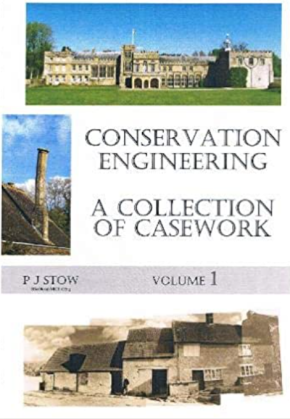Conservation Engineering: a collection of casework, Volume 1

|
| Conservation Engineering: a collection of casework, Volume 1, PJ Stow, Short Run Press, 2019, 864 pages, more than 600 colour photographs and more than 400 diagrams, hardback. |
There is no rulebook for the structural repair of historic buildings, but Patrick Stow’s comprehensive collection of casework forms an excellent guide to the principles and art of the possible.
Stow practiced in the West Country as a chartered engineer running his own consultancy specialising in conservation, and the book is the culmination of 25 years of experience. Further volumes are planned, and a companion of much slimmer proportions tells the story of the gestation of Volume 1, revealing the challenges of self-publishing and the unstinting effort which goes into such a project.
This substantial volume is divided into colour-coded sections, which group the 75 case studies according to elements of building structure such as roofs, walls and foundations. Each section is prefaced with a pictogram index, making it easy to reference cases similar to the scenario the reader may be faced with today. The scene is set for each case in the form of a brief explanation of the problem, diagnosis and structural solution, and the reader is taken on a well-explained journey using original material from project files.
Site notes, report extracts and lovely hand-drawn diagrams are freshly annotated, which helps tie together the sometimes disparate collection of material. Before-and-after photographs, together with photos of works in progress, do much to convey succinctly to the reader the essence of each case. Ideas are discussed without forming a prescriptive authority on what should be done. Of particular note are the insightful comments in blue on top of original material; Stow peppers the text with additional nuggets about each project. These add context, and allow his personality and enthusiasm for his work to come across. This turns what could have been a dry technical tome into an enjoyable read.
Subjects range from agricultural and industrial buildings through to dwellings, churches and country houses; interventions comprise predominantly repairs but also sensitive alterations to allow conversion and new uses. If there is an underlying characteristic to the repairs it is their simplicity, adding no more or less than is needed to gently assist the existing structure. That is the sign of good conservation engineering.
Several of the case studies demonstrate how small additions made to existing timber structures can enhance strength substantially. A notable example is a vertical tension wire applied from apex down to tie beam on a failing braced truss, effectively turning it into a king post truss. This judicious use of steel restores structural integrity with no loss of original fabric, and is truly elegant.
Another case, extending to a full 30 pages, including calculations, deals with advanced decay in the ringing chamber floor of a church tower. Discovered in the nick of time, we learn of the temporary measures taken to allow bell ringing at imminent weddings, discoveries made during opening-up, the repair options considered, and the final solution involving a combination of traditional carpentry repairs and new reinforcement, all based on a thorough understanding of the original.
For me the delight in this book is that it deals with real projects. We see the theory applied to real situations, how the result was executed on site, and what was learnt in the process. A student or practitioner wishing to develop their skills in the repair of historic structures should reach for this book and absorb the technical detail. For others with an interest in the conservation of old buildings it can be enjoyed through the photos, diagrams and prose. If only more of us found time to collate a lifetime’s work.
See also: Conservation Engineering: a collection of casework, Volume 2.
This article originally appeared as ‘A lifetime’s casework’ in Context 165, published by The Institute of Historic Building Conservation in August 2020. It was written by Simon Malam, conservation accredited architect, Donald Insall Associates.
--Institute of Historic Building Conservation
Related articles on Designing Buildings Wiki
- Building archaeology and conservation.
- Conservation as action and reaction.
- Conservation.
- Conservation Engineering: a collection of casework, Volume 2.
- Digital techniques for heritage restoration.
- Heritage.
- IHBC articles.
- Listed buildings.
- Reconciling conservation and sustainable development.
- Renovation.
- Restoration.
IHBC NewsBlog
Images from inside a Grade II listed hotel show the scale of its collapse
The Corbett Arms in Tywyn has fallen into serious disrepair.
Old Sarum fire in listed (& disputed) WW1 Hangar - Wiltshire Council has sought legal advice after fire engulfed a listed First World War hangar that was embroiled in a lengthy planning dispute.
UK Antarctic Heritage Trust launches ‘Virtual Visit’ website area
The Trust calls on people to 'Immerse yourself in our heritage – Making Antarctica Accessible'
Southend Council pledge to force Kursaal owners to maintain building
The Council has pledged to use ‘every tool in the toolbox’ if urgent repairs are not carried out.
HE’s Research Magazine publishes a major study of the heritage of England’s suburbs
The article traces the long evolution of an internal programme to research 200 years of suburban growth
IHBC Context 183 Wellbeing and Heritage published
The issue explores issues at the intersection of heritage and wellbeing.
SAVE celebrates 50 years of campaigning 1975-2025
SAVE Britain’s Heritage has announced events across the country to celebrate bringing new life to remarkable buildings.
IHBC Annual School 2025 - Shrewsbury 12-14 June
Themed Heritage in Context – Value: Plan: Change, join in-person or online.
200th Anniversary Celebration of the Modern Railway Planned
The Stockton & Darlington Railway opened on September 27, 1825.
Competence Framework Launched for Sustainability in the Built Environment
The Construction Industry Council (CIC) and the Edge have jointly published the framework.














